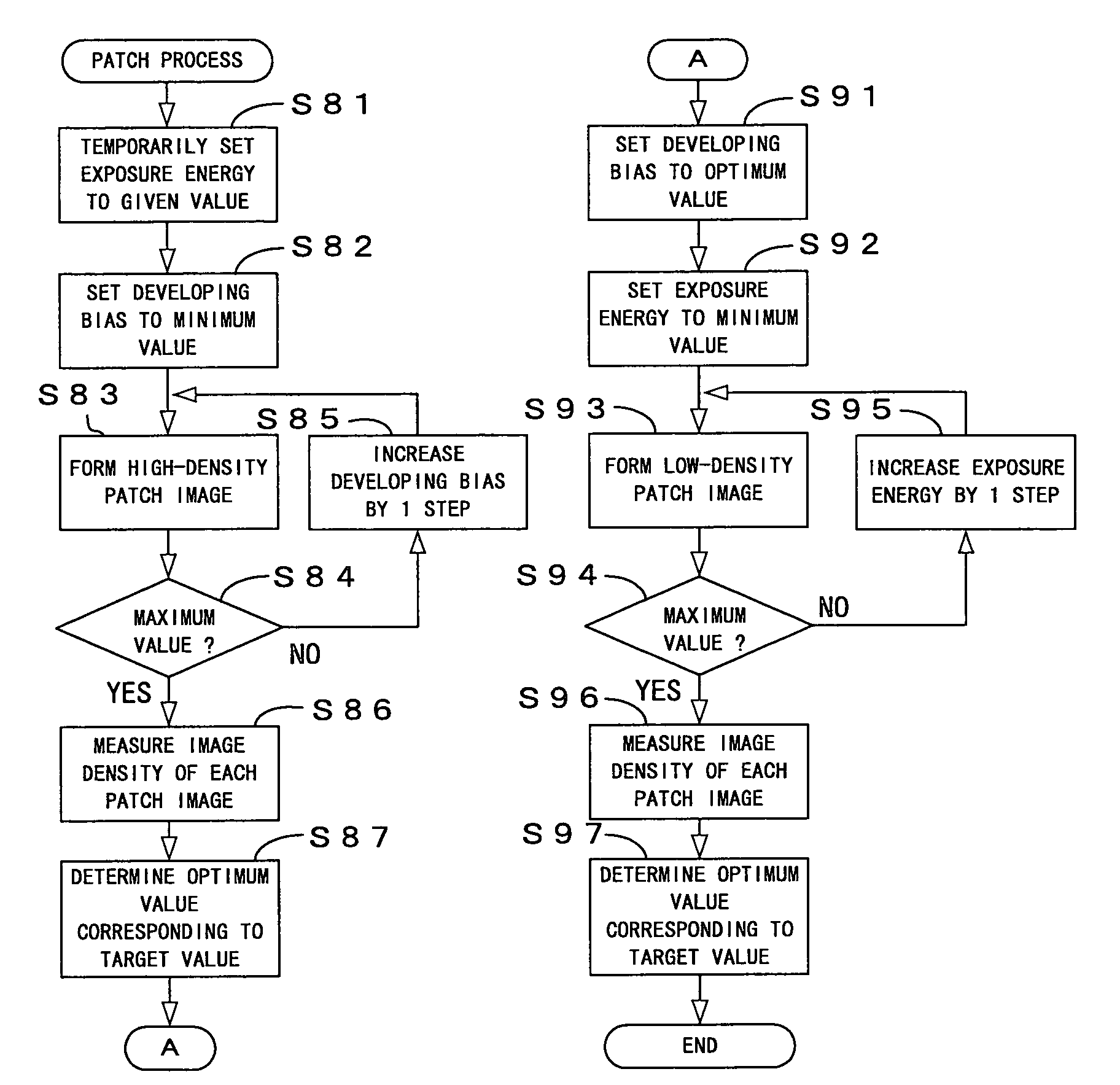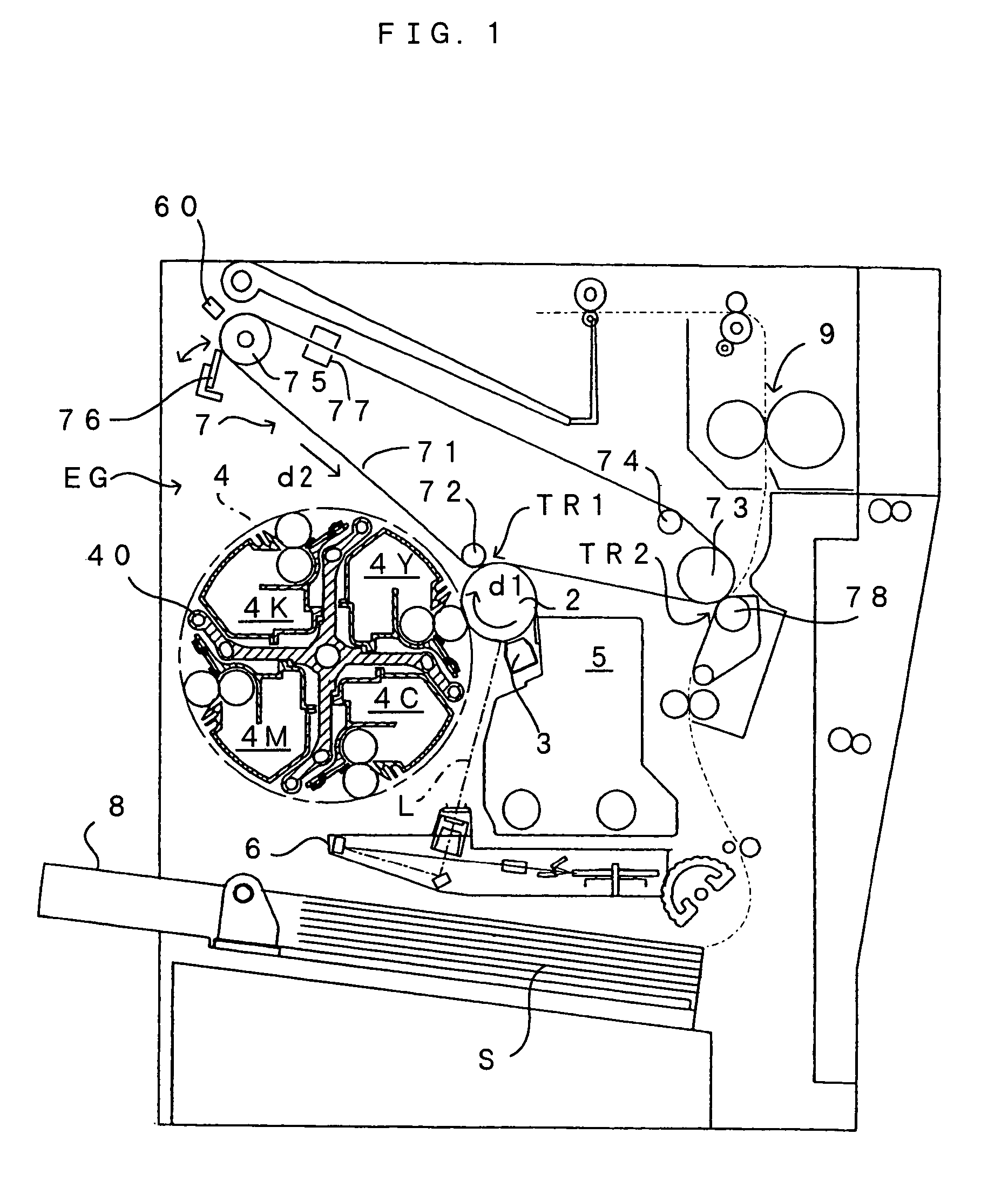Image forming apparatus and image method for forming toner images with optimized patch image density
a technology of image forming apparatus and patch image density, which is applied in the direction of electrographic process apparatus, instruments, optics, etc., can solve problems such as detection errors, and achieve the effect of increasing the cost of the apparatus and simplifying the control
- Summary
- Abstract
- Description
- Claims
- Application Information
AI Technical Summary
Benefits of technology
Problems solved by technology
Method used
Image
Examples
first embodiment
(1) Arrangement of Apparatus
[0080]FIG. 1 is a diagram showing an image forming apparatus according to a first embodiment of the present invention, whereas FIG. 2 is a block diagram showing an electrical arrangement of the image forming apparatus of FIG. 1. The image forming apparatus is adapted to form a full-color image by superimposing toner images of four colors, including yellow (Y), cyan (C), magenta (M) and black (K), on one another or to form a monochromatic image using a black (K) toner alone. The image forming apparatus operates as follows. When an external apparatus such as a host computer supplies an image signal to a main controller 11 in response to a user demand for forming an image, an engine controller 10 functioning as “image forming means” of the present invention responds to the command from the main controller 11. The engine controller 10 controls individual portions of an engine EG whereby an image corresponding to the image signal is formed on a sheet S.
[0081]T...
second embodiment
[0216]FIG. 28 is a diagram showing a light-quantity control signal conversion section according to a second embodiment. In the apparatus of the first embodiment (FIG. 4), the CPU 101 outputs the light-quantity control signal Slc directly to the irradiation-light-quantity regulating unit 605 of the density sensor 60. In contrast, the apparatus of the second embodiment differs from that of the first embodiment in that a light-quantity control signal conversion section 200 is interposed between the CPU 101 and the irradiation-light-quantity regulating unit 605.
[0217]The light-quantity control signal conversion section 200 operates to supply a light-quantity control signal Slc to the irradiation-light-quantity regulating unit 605 of the density sensor 60, the light-quantity control signal Slc having a voltage value based on two types of digital signals DA1 and DA2 outputted from the CPU 101 for light quantity control. The light-quantity control signal conversion section 200 includes two...
third embodiment
[0243]Next, description is made on an image forming apparatus according to a third embodiment of the present invention. The image forming apparatus of this embodiment is constructed by adding the light-quantity control signal conversion section 200 of the second embodiment to the image forming apparatus of the first embodiment described above. As will be described hereinlater, however, the arrangement of the apparatus is partially varied and hence, a part of the optimization process for density control factor is also changed. Of the arrangement of the apparatus and the optimization process for density control factor, the description is made on differences from the foregoing first and second embodiments on an item-by-item basis and the explanation on the common features to these embodiments is dispensed with.
(1) Difference in the Apparatus Arrangement
[0244]According to the description of the first embodiment described above, the density sensor 60 (FIG. 4) is constructed such that the...
PUM
 Login to View More
Login to View More Abstract
Description
Claims
Application Information
 Login to View More
Login to View More - R&D
- Intellectual Property
- Life Sciences
- Materials
- Tech Scout
- Unparalleled Data Quality
- Higher Quality Content
- 60% Fewer Hallucinations
Browse by: Latest US Patents, China's latest patents, Technical Efficacy Thesaurus, Application Domain, Technology Topic, Popular Technical Reports.
© 2025 PatSnap. All rights reserved.Legal|Privacy policy|Modern Slavery Act Transparency Statement|Sitemap|About US| Contact US: help@patsnap.com



